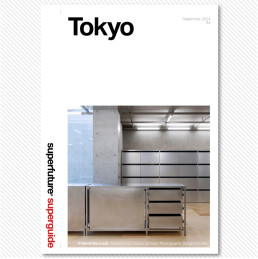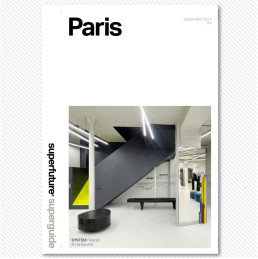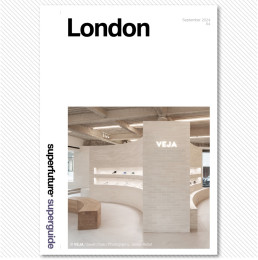
With her astutely cosmopolitan mindset, Kate Hume has designed a wide range of private homes and public spaces across the world, infusing each location with her sophisticated style and inimitable joie de vivre. Formerly a seasoned fashion stylist across the Big Pond, Hume changed tracks, relocating to the Dutch capital in the 1990s and eventually establish a design practice there. It didn’t take long before here new career took off, and to this day, the British-born designer has thrived due to her ability to pair an innate sense of colour and style with excellent sourcing and curating of materials and artisanal craftsmanship. Rizzoli‘s upcoming release of Élan: The Interior Design of Kate Hume will certainly be a bold new highlight in Hume’s long career. The 224-page hardcover book, the designer’s first, elaborates on the many private homes that she has designed, revealing her ability to create narratives with layers of texture, fascinating objects and vibrant shades, and the furniture pieces and decorative objects she designs in collaboration with her husband Frans van der Heijden. Superfuture sat down with the designer to chat about here flourishing practice, her view on design and, given the current circumstances, the future of design.
Your first book, Élan: The Interior Design of Kate Hume, is to be released by Rizzoli coming November. How did the book come about and could you elaborate a little on its timeline? I had wanted to produce a book for some time and was looking at ways to make this happen. In fact, Rizzoli came to me with a proposal several years ago and we set off on this journey. Of course, the publication has been delayed due to the current pandemic, but luckily, we had all the elements in place before the lock down. With more emphasis on creating comfortable, inspirational homes I hope its release is timely.
Prior to becoming an interior designer, you were a fashion stylist. Is there an overlap of the two professions, and do you apply any useful tricks from your former job in your current practice apart from the styling element? I think all creative endeavours are related, but of course there’s a financial and management element to interior design, for which my years producing commercial shoots was very good training. I still love fashion, or at least style! So, it does inform my work, but in a subliminal way. I love to style private homes, but it’s important that the spaces still look real, as opposed to stage sets. The most important design principle is to listen to the client, and then try to go beyond what they can imagine they need. With so much imagery available nowadays, clients often come with strong ideas of what they want, and my job is to tweak that into a cohesive and exciting reality, obviously with my signature. For several years now I’ve been championing craft in design and I love to bring elements of this into my work. One can’t help but be influenced by trends. Again, we’re surrounded by so much information, but I prefer to work on projects where I can create a space that has its own enduring identity. I look to create spaces that will look just as good in 15 to 20 years. It’s not a very sustainable business model, but anything less than this timespan would be wasteful.
Your career spans both the analogue and digital eras. How has this transition changed your design practice and creative output? I love to research a project. It may not be wholly apparent in the finished design, but this provides a starting point for me. I still do buy books for research whenever possible, and there’s one Pinterest board that I always look at, as it’s an extremely good catalogue of what’s happening in design right now. I still feel the best inspiration is to go out and look at something. Also, I have a mental data bank of what I’ve seen over the years.
You say your parents have actively instilled a sense of aesthetic during your formative years. To which extent has this influenced your career and creative output? I was lucky enough to grow up in family where creativity was the norm, but it was more pragmatic in nature. We didn’t have much money, so we had to create things. My parents made all our Christmas presents, my mother made our clothes, but there was nothing haphazard about this—the presents, and the clothes were beautifully made. So, it was more of a practical than artistic background. I was allowed to design and furnish my own bedrooms, and I took this very seriously! I had no intention of being an interior designer when I was a little girl, but it seemed essential to me to be able to do this, to create my own atmosphere.
The appliance of elements of artisanal craftsmanship adds a distinctive layering to your work. How do you go about sourcing the right people for a project? I try to be very loyal to the crafts people we work with. I am so impressed with what they know, with the problems they can solve. I’d never cut corners on this part of our work. Over the years we have built up a team that really can read my mind. We usually try to have fun in the process too. It’s a wonderfully collaborative job.
Your designs for private clients and companies ooze luxury. What’s your personal definition of luxury, and do you think this definition has evolved over the years? To me, the most important element is that the client loves the space and feels that its theirs. So, if they require a deeply luxurious environment, I try to deliver that. Some people really do dine with crystal and porcelain every day. But I also create easy environments that are more basic. Our country houses are a bit more ‘wash and go’. To create a space that has longevity, that can be built on as families grow, or change is important to me. Also, perceptions of luxury have changed. I used to really enjoy racing around, and maybe I will get back to that, but right now, I think space, land, fresh air, and the company of a few interesting people is a luxury. I have spent the pandemic in the deep countryside, and it has been such a privilege.
The global pandemic has affected almost every aspect of life. How do you view the future of design in general? Obviously, people’s homes will have to be re-thought to create integrated working and living spaces. I’ve always lived like this, so it’s a bit of a no brainer, but the one bedroom or studio flat is no longer tenable if you need to work from home. I believe two things will happen—more people moving to rural locations, looking for the space and land I really cherish. There can be such a regeneration of the countryside, particularly in the isolated parts of Southern Europe. With talk of far fewer people wanting to commute to the skyscrapers of New York City or London, maybe cities will become more vibrant living spaces rather than working spaces. And again, sustainability, obviously in an environmental sense, but also in the sense that if you buy something good it will last. I’m looking at a sofa right now, which I bought 30 years ago in London, and I still love it. I believe it will be a very interesting period for my profession.
Your home town Amsterdam has changed quite a lot on many levels since the early 2000s. How do you view this urban transformation both as a designer and seasoned global traveller? When I first came to Amsterdam, you could barely get a decent coffee, and you certainly couldn’t go out for breakfast, something I just love about city life. These days, It’s far too busy of course. Airbnb and cheap holiday rentals are huge problems. Having said that, I do enjoy the slightly more international vibe with the arrival of Soho House and other establishment. The new subway line was so contentious, but is in fact amazing.
Your job must have provided you a Rolodex full of favourite addresses. Could you fill us in on some of your fav hotspots in the Dutch capital and beyond? Certainly, I’ve drafted a little list with some worthwhile places for you:
Amsterdam is mostly just the basic things…you must know I live a very quiet life when I’m at home!
Buffet van Odette, Rijsel, and Café de Kepel are some of my fave restaurants
Noordermarkt for organic food shopping on Saturdays
Rika for women’s shirts
Zwart Wit for reading books
Mendo for all other book
Pompon for beautiful flowers
Grimm Gallery for modern art
London
Royal Academy of Art for interesting art shows
Tate Britain this museum is true bliss!
Clipstone and Bocca di Lupo for lunch
Ham Yard for a stylish sleepover
Brasserie Zédel this restaurant is great fun
Connolly and Mouki Mou for well-designed clothes
Soane and Rose Uniacke on Pimlico Road for traditional British furniture
The New Craftsmen for curated British craftsmanship
Paris
Ogata for excellent Japanese gastronomy and style
Buly for perfume
Musée Bourdelle

Publishers Note
Just to be clear – superfuture® is a design blog and not a political commentator. No surprise there. The scope of our content has always been global and borderless, however that can often mean covering projects in countries where we will not agree with the politics or actions of those countries. In a world that’s as screwed up as ever right now, the focus of our support is to those designers, architects and other creatives who aim to make the world a more liveable one – as opposed to people that try their hardest to destroy it. So if a project hits our desk and we like it based on its design credentials, we may choose to publish regardless of its location or creators nationality. superfuture® has always been inclusive and hopes for all current wars, aggression, violence, hate and extremism to end.





